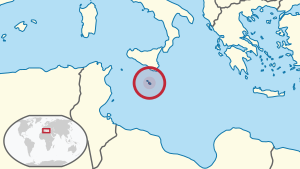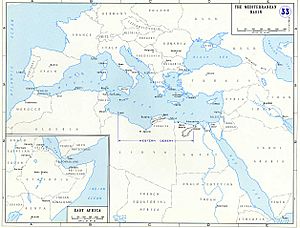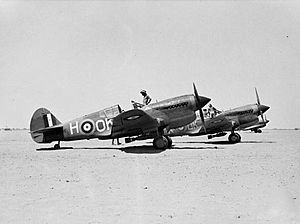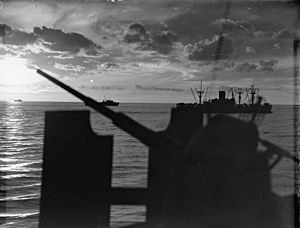Operation Stoneage facts for kids
Quick facts for kids Operation Stoneage |
|||||||
|---|---|---|---|---|---|---|---|
| Part of the Battle of the Mediterranean of the Second World War | |||||||
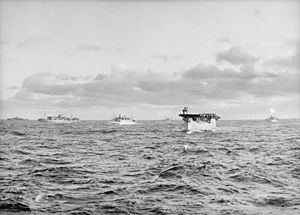 View from HMS Manxman during Operation Stoneage, November 1942 |
|||||||
|
|||||||
| Belligerents | |||||||
| Strength | |||||||
| 3 light cruisers 10 destroyers 4 cargo ships |
Air & naval forces | ||||||
| Casualties and losses | |||||||
| 156 men light cruiser seriously damaged 5 aircraft lost |
|||||||
Operation Stoneage (also called Operation Stone Age) was an important mission during World War II. It happened from November 16 to 20, 1942. This operation was about sending supplies to the island of Malta in the Mediterranean Sea. Malta was under a long attack by enemy forces.
To keep the mission a secret, some ships loaded their goods far away in Port Sudan. Four cargo ships, known as Convoy MW 13, left Alexandria on November 16. They had strong protection from warships like cruisers and destroyers. Airplanes also guarded them day and night. These planes flew from airfields in Egypt and Libya that the Allies had captured.
Another supply mission from Gibraltar was canceled. This happened because Allied troops, who landed in North Africa during Operation Torch, moved slower than expected. Convoy MW 13 sailed close to the African coast. Then, it turned north towards Malta. British code-breakers helped by listening to German secret messages. They found out that the enemy could not stop the Allies.
On November 18, enemy planes attacked the convoy. A torpedo hit the cruiser HMS Arethusa. This attack sadly killed 156 crew members. The Arethusa had to slowly return to Alexandria. Convoy MW 13 finally reached Malta early on November 20. This arrival helped end the long Siege of Malta, which had lasted since June 1940.
Contents
Why This Mission Was Important
The Battle for the Mediterranean
Malta was a key island in the Mediterranean Sea during World War II. Even though the British lost many ships, they held onto Malta. Earlier, in August 1942, a mission called Operation Pedestal brought much-needed fuel and supplies. This helped British submarines and planes based on Malta to fight back.
These submarines and planes attacked enemy supply ships. They focused on fuel tankers. British code-breakers helped by sharing secret information about these ships. In September, the enemy forces in Egypt lost a lot of supplies, including fuel.
Losing these supplies made it hard for the enemy army to move. This affected battles like the Battle of Alam Halfa and the Second Battle of El Alamein. As the enemy army retreated, their air forces had to keep moving their airfields. The Italian Navy was a big threat to Malta convoys. They had many powerful battleships and cruisers.
Malta's Supply Needs
Malta needed constant supplies to survive the siege. In October, submarines brought aircraft fuel, food, and torpedoes to the island. Another mission, Operation Train, delivered 27 Supermarine Spitfire fighter planes to Malta.
Other attempts were made to get ships to Malta. One fast ship, HMS Manxman, sailed from Alexandria. It arrived two days later with milk, cereals, and meat. Another ship, HMS Welshman, also reached Malta on November 18. These missions were vital for keeping Malta supplied and fighting.
Getting Ready for the Convoy
Allied Air Power
The Allied air forces played a big part in protecting the convoy. They had different types of planes for different jobs. Some planes looked for enemy submarines. Others were torpedo-bombers or long-range fighters.
Planes from Egypt and Libya would protect the convoy for the first part of its journey. Then, planes from Malta would take over. This plan made sure the convoy had air cover almost all the time. As the enemy retreated, Allied planes could use their captured air bases. This made it easier to protect the convoy.
The Convoy Plan
Convoy MW 13 included four cargo ships: the British Denbighshire, the Dutch Bantam, and the US ships Robin Locksley and Mormacmoon. These ships carried important supplies.
They were protected by many warships. This included three light cruisers: HMS Arethusa, Orion, HMS Cleopatra, Euryalus, and Dido. Ten destroyers also joined the escort. For safety, some cargo ships loaded their goods in secret at Port Sudan. They even had extra sandbag protection.
The ships met at Suez Bay and went through the Suez Canal. They then entered the Mediterranean Sea. Their plan was to sail along the coast of Cyrenaica (eastern Libya). They would stay within reach of Allied fighter planes. After two days, they would turn north towards Malta.
Fighting on Land
While the convoy sailed, the Eighth Army was fighting on land. They recaptured important towns like Mersa Matruh, Bardia, and Tobruk. This meant that Allied airfields closer to the convoy's route could be used.
The enemy forces were running out of fuel. Secret messages showed they had only a few days of fuel left. This made it hard for them to fight back. Allied planes could use the captured airfields to protect the convoy as it moved closer to Malta.
Convoy MW 13 in Action
November 16–18
The convoy started its journey through the Suez Canal on November 16. It left Port Said with its cruiser and destroyer escorts. More destroyers joined the convoy off Alexandria. Anti-submarine planes flew patrols around the clock. Fighter planes also guarded the convoy during dawn and dusk.
On November 17, enemy bombers attacked the convoy. But Kittyhawk fighter planes from the Royal Australian Air Force (RAAF) drove them away. There were no more attacks that day.
As night fell, the cruisers and most destroyers separated from the convoy. Both groups were then attacked by enemy torpedo-bombers. The cargo ships were not hit. However, the cruiser Arethusa was hit by a torpedo near its front. It caught fire and leaned to one side. Sadly, 156 sailors were killed, and many more were hurt. Another destroyer, Petard, had to tow the damaged Arethusa back to Alexandria.
November 19–20
At dawn, the warships rejoined the convoy. Fighter planes from Malta, including Bristol Beaufighters and Supermarine Spitfires, provided air cover. Reconnaissance planes flew ahead to scout for danger. Communication between the ships and planes was much better thanks to new radio systems.
When the convoy was about 80 miles from Malta, the main cruiser squadron and fleet destroyers turned back to Alexandria. The remaining ships, including Euryalus and the 12th Destroyer Flotilla, continued to Malta. They were met by local minesweepers.
At 1:30 a.m. on November 20, the ships entered Grand Harbour in Malta. The people and soldiers on the island cheered loudly. Unloading began quickly. By November 26, the supplies had greatly helped Malta. Enemy planes tried to bomb the ships, but a small fire on one of the cargo ships was the only other danger.
After the Mission
Losses
The attack on the Arethusa caused the deaths of 156 sailors. Many others were badly injured, some with severe burns. The Royal Air Force (RAF) lost five aircraft during the operation, including three Spitfires.
See also
Images for kids



